Enhancing Crystallinity and Orientation by Hot-Stretching to Improve the Mechanical Properties of Electrospun Partially Aligned Polyacrylonitrile (PAN) Nanocomposites
Abstract
:1. Introduction
2. Experimental Section
2.1. Materials
2.2. Formation of Electrospun PAN Nanofibers and PAN/SWNTs Composite Nanofibers
2.3. Hot-Stretching
2.4. Morphologies of Nanofibers
2.5. Crystallinities and Orientation of the As-Spun and Hot-Stretched PAN Nanofibers
2.6. Thermal Analysis
2.7. Mechanical Properties
3. Results and Discussion
3.1. Morphologies

3.2. Morphology of SWNTs in PAN/SWNTs Composite Nanofibers

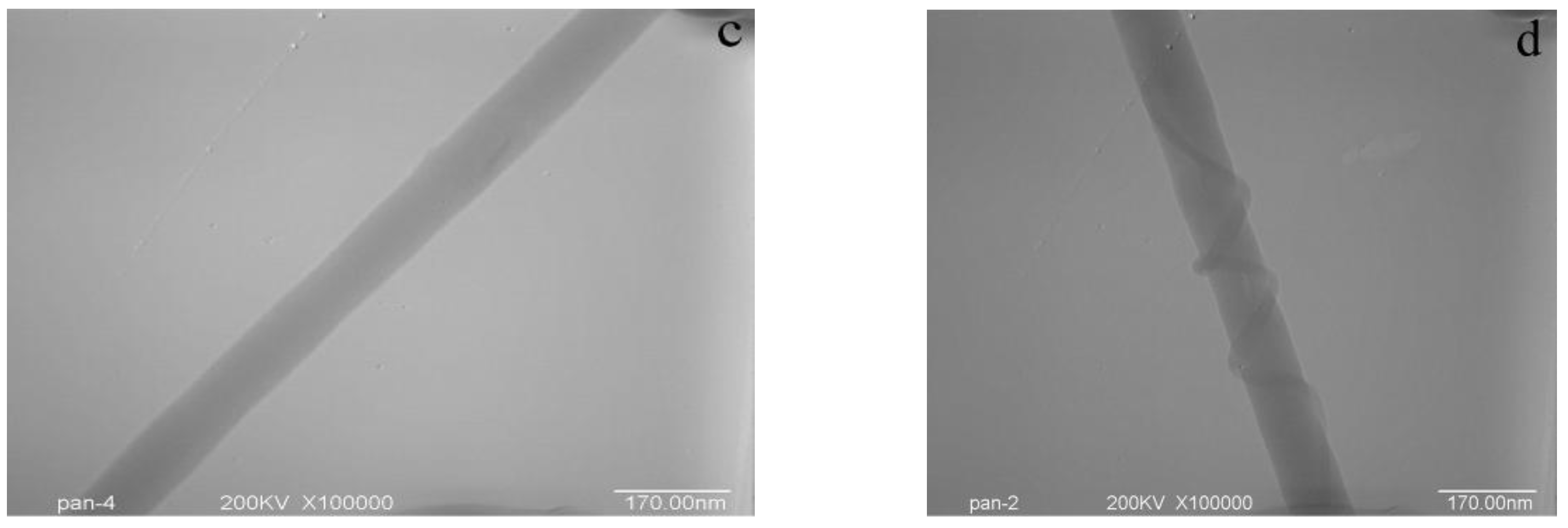
3.3. Crystallinities and Orientation of the As-Spun and Hot-Stretched PAN Nanofibers
| Nanofiber | Crystallinity (%) | Crystallite size(nm) | Orientation factor f |
|---|---|---|---|
| As-spun | 11.27 | 4.14 | 0.22 |
| Hot-stretched | 38.34 | 10.83 | 0.76 |
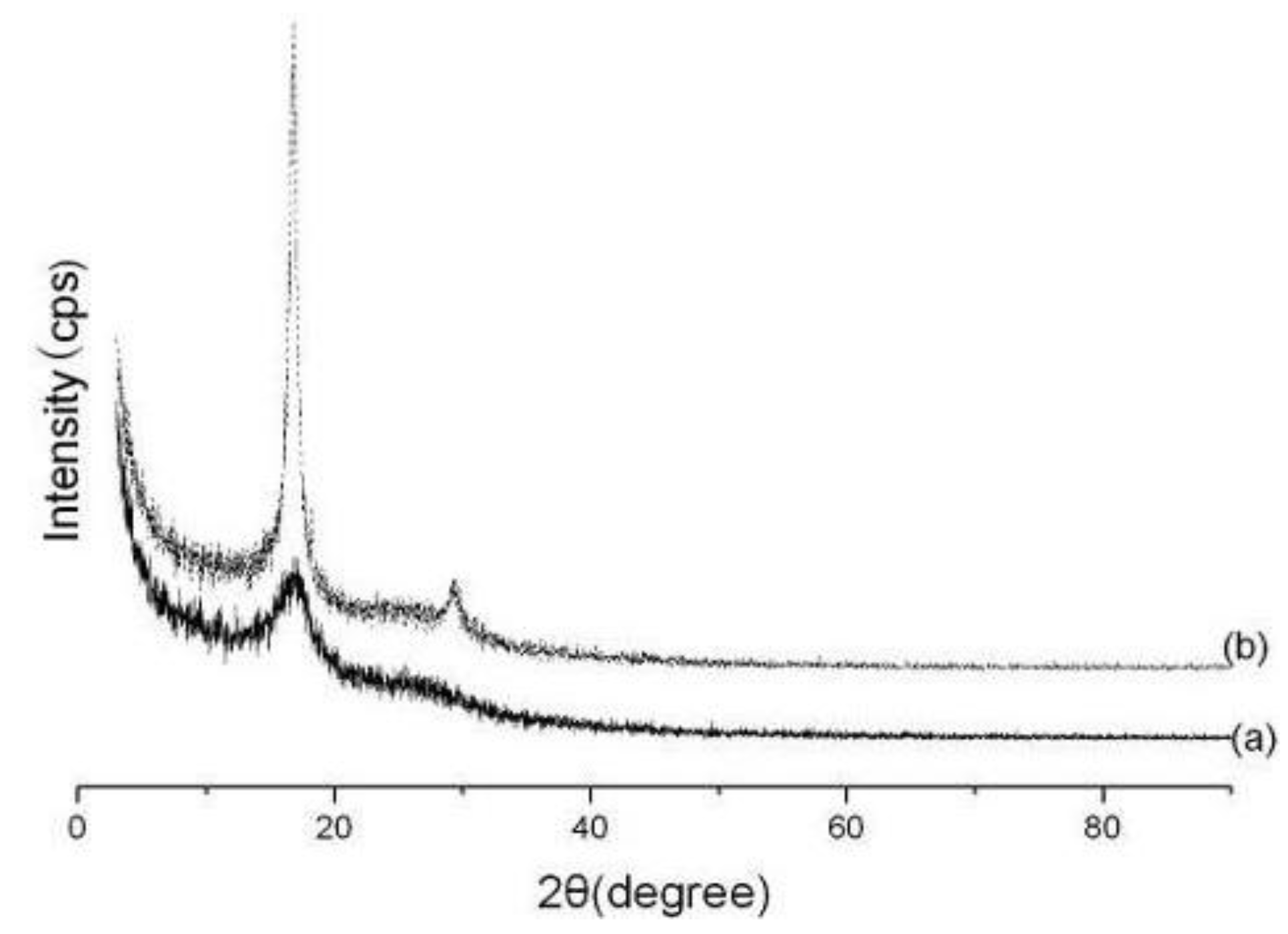
3.4. Thermal Behavior
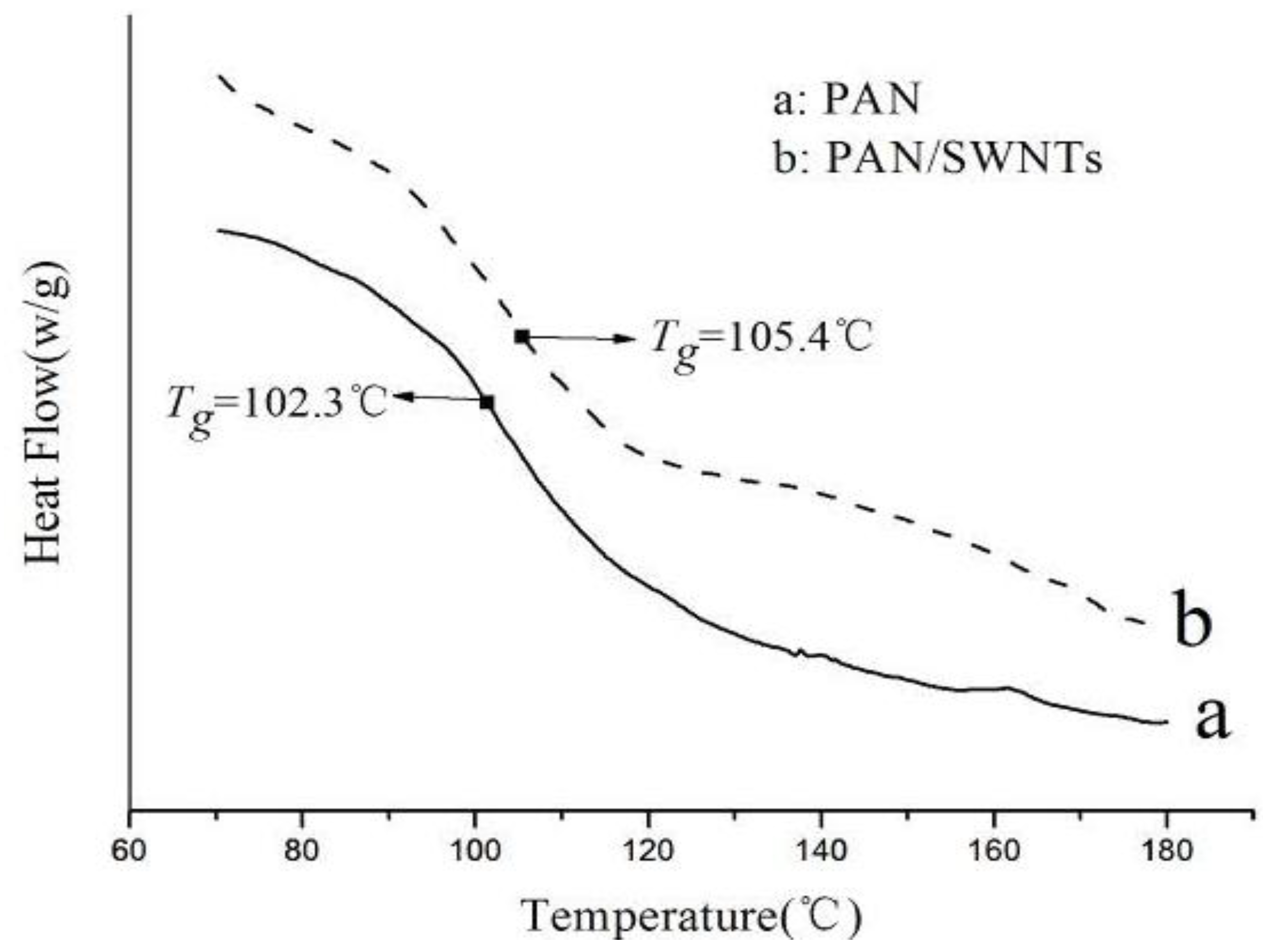
3.5. Mechanical Properties
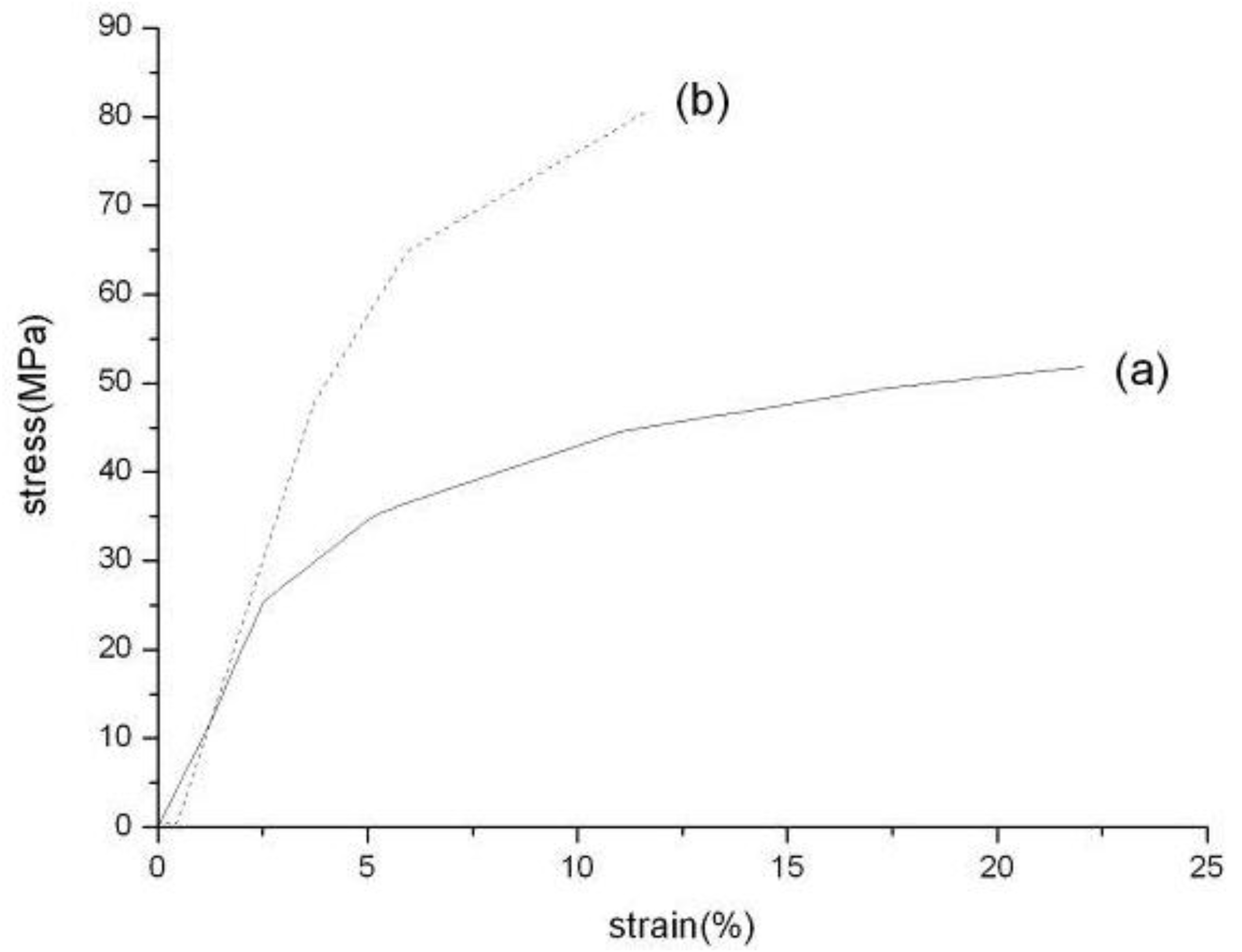
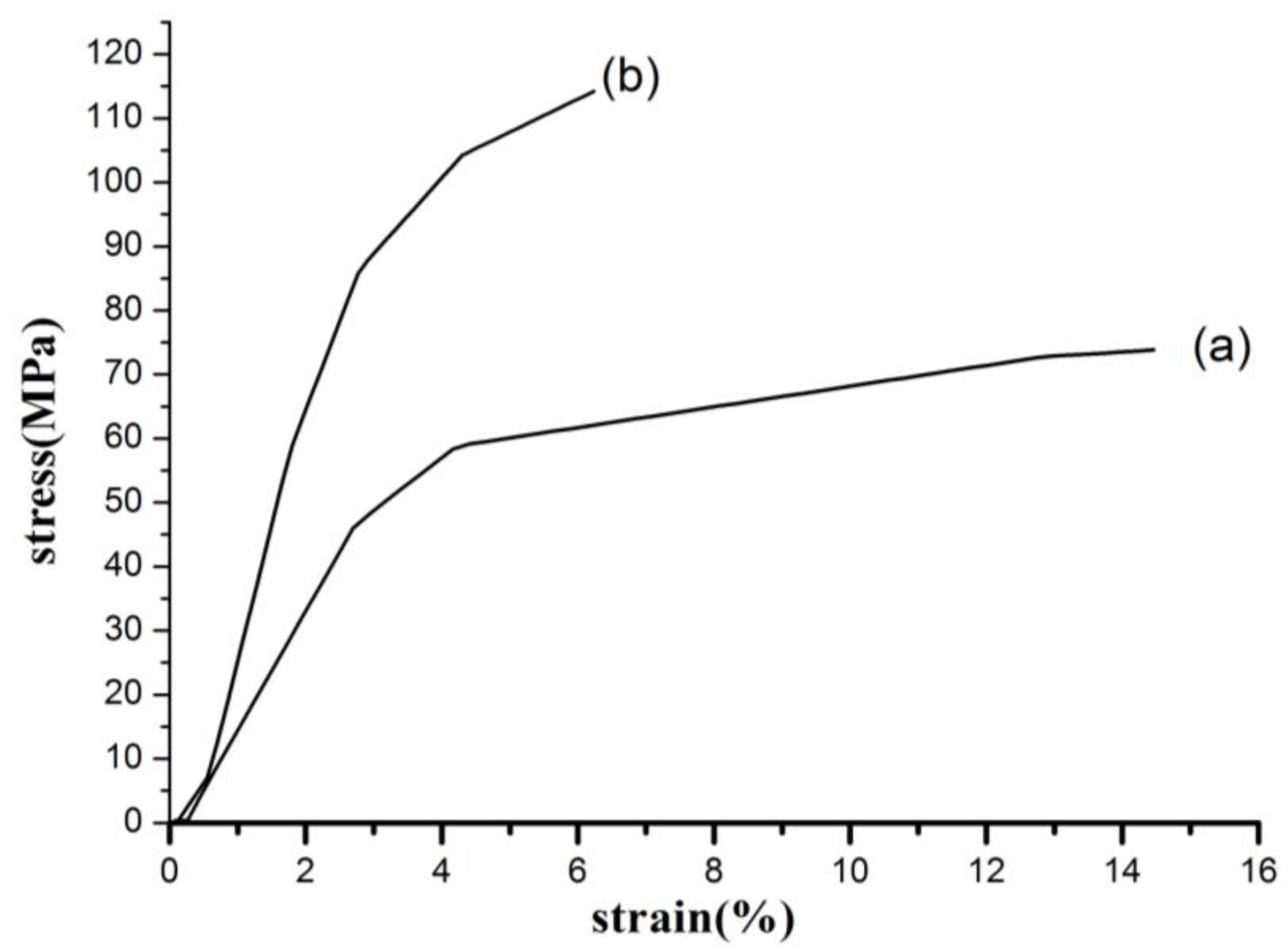
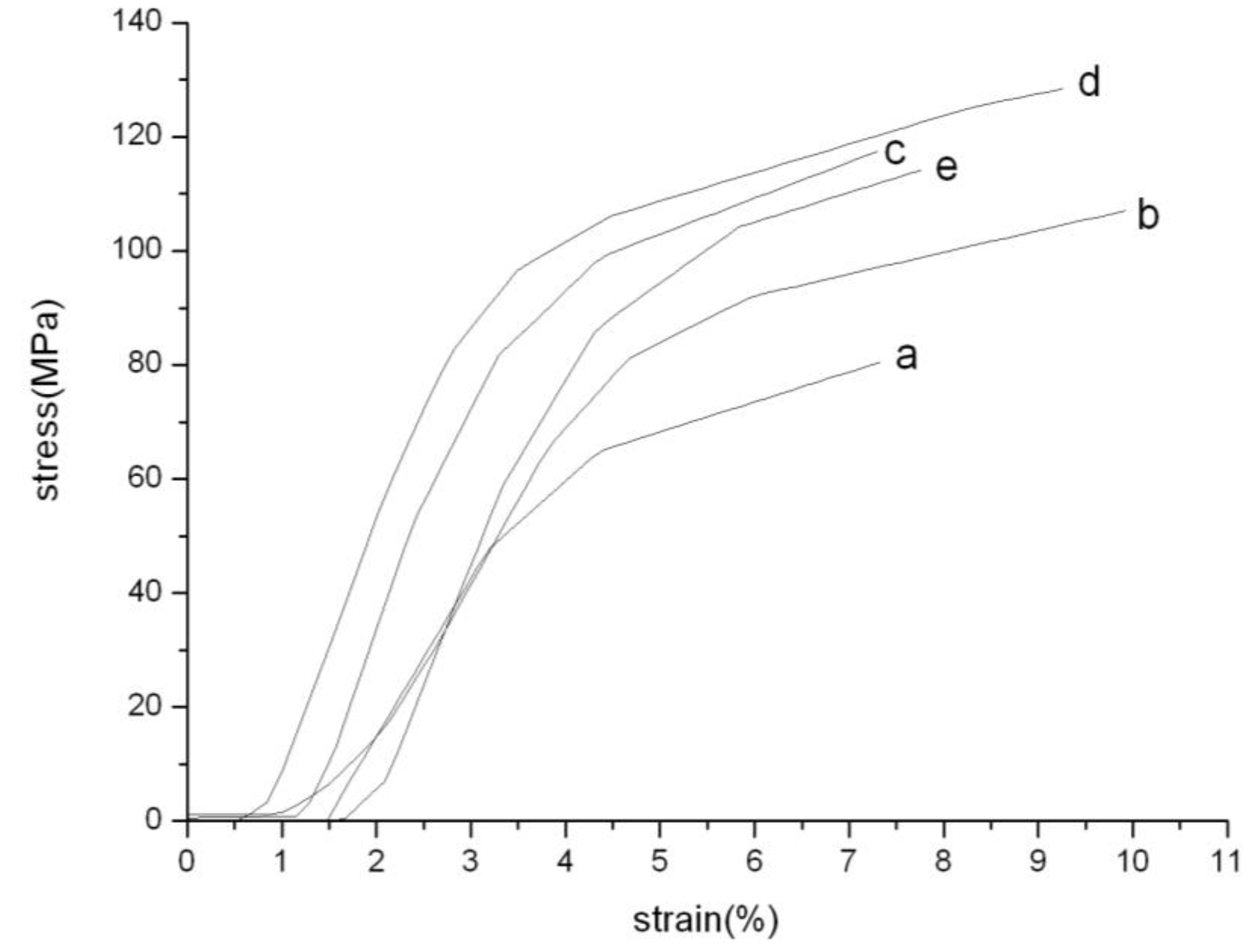
4. Conclusions
Acknowledgements
References
- Yu, M.F.; Lourie, O.; Dyer, M.J.; Moloni, K.; Kelly, T.F.; Ruoff, R.S. Strength and breaking mechanism of multi-walled carbon nanotubes under tensile load. Science 2000, 287, 637–640. [Google Scholar] [CrossRef] [PubMed]
- Wong, E.W.; Sheehan, P.E.; Lieber, C.M. Nanobeam mechanics: Elasticity, strength, and toughness of nanorods and nanotubes. Science 1997, 277, 1971–1975. [Google Scholar] [CrossRef]
- Javey, A.; Guo, J.; Wang, Q.; Lundstrom, M.; Dai, H.J. Ballistic carbon nanotube field-effect transistors. Nature 2003, 424, 654–657. [Google Scholar] [CrossRef] [PubMed]
- Miaudet, P.; Bartholome, C.; Derre, A.; Maugey, M.; Sigaud, G.; Zakri, C.; Poulin, P. Thermo-electrical properties of PVA-nanotube composite fibers. Polymer 2007, 48, 4068–4074. [Google Scholar] [CrossRef]
- Coleman, J.N.; Khan, U.; Blau, W.J.; Gun’ko, Y.K. Small but strong: A review of the mechanical properties of carbon nanotube-polymer composites. Carbon 2006, 44, 1624–1652. [Google Scholar] [CrossRef]
- Coleman, J.N.; Khan, U.; Gun’ko, Y.K. Mechanical reinforcement of polymers using carbon nanotubes. Adv. Mater. 2006, 18, 689–706. [Google Scholar] [CrossRef]
- Moniruzzaman, M.; Winey, K.I. Polymer nanocomposites containing carbon nanotubes. Macromolecules 2006, 39, 5194–5205. [Google Scholar] [CrossRef]
- Xu, M.; Zhang, T.; Gu, B.; Wu, J.L.; Chen, Q. Synthesis and properties of novel polyurethane-urea/multiwalled carbon nanotube composites. Macromolecules 2006, 39, 3540–3545. [Google Scholar] [CrossRef]
- Chandrasekar, R.; Zhang, L.F.; Howe, J.Y.; Hedin, N.E.; Zhang, Y.; Fong, H. Fabrication and characterization of electrospun titania nanofibers. J. Mater. Sci. 2009, 44, 1198–1205. [Google Scholar] [CrossRef]
- Hao, R.; Yuan, J.Y.; Peng, Q. Fabrication and sensing behavior of Cr2O3 nanofibers via in situ gelation and electrospinning. Chem. Lett. 2006, 35, 1248–1249. [Google Scholar] [CrossRef]
- Chen, J.; Ramasubramaniam, R.; Xue, C.; Liu, H. A versatile molecular engineering approach to simultaneously enhanced, multifunctional carbon-nanotube-polymer composites. Adv. Funct. Mater. 2006, 16, 114–119. [Google Scholar] [CrossRef]
- Blond, D.; Barron, V.; Ruether, M.; Ryan, K.P.; Nicolosi, V.; Blau, W.J.; Coleman, J.N. Enhancement of modulus, strength, and toughness in poly(methyl methacrylate)-based composites by the incorporation of poly(methyl methacrylate)-functionalized nanotubes. Adv. Funct. Mater. 2006, 16, 1608–1614. [Google Scholar] [CrossRef]
- Na, H.; Li, Q.Y.; Sun, H.; Zhao, C.; Yuan, X.Y. Anisotropic mechanical properties of hot-pressed pvdf membranes with higher fiber alignments via electrospinning. Polym. Eng. Sci. 2009, 49, 1291–1298. [Google Scholar] [CrossRef]
- Ra, E.J.; An, K.H.; Kim, K.K.; Jeong, S.Y.; Lee, Y.H. Anisotropic electrical conductivity of MWCNT/PAN nanofiber paper. Chem. Phys. Lett. 2005, 413, 188–193. [Google Scholar] [CrossRef]
- Liu, L.Q.; Tasis, D.; Prato, M.; Wagner, H.D. Tensile mechanics of electrospun multi-walled nanotube/poly(methyl methacrylate) nanofibers. Adv. Mater. 2007, 19, 1228–1233. [Google Scholar] [CrossRef]
- Chand, S. Review carbon fibers for composites. J. Mater. Sci. 2000, 35, 1303–1313. [Google Scholar] [CrossRef]
- Hou, H.Q.; Ge, J.J.; Zeng, J.; Li, Q.; Reneker, D.H.; Greiner, A.; Cheng, S.Z.D. Electrospun polyacrylonitrile nanofibers containing a high concentration of well-aligned multiwall carbon nanotubes. Chem. Mater. 2005, 17, 967–973. [Google Scholar] [CrossRef]
- McCann, J.T.; Marquez, M.; Xia, Y. Highly porous fibers by electrospinning into a cryogenic liquid. J. Am. Chem. Soc. 2006, 128, 1436–1437. [Google Scholar] [CrossRef] [PubMed]
- Dror, Y.; Salalha, W.; Khalfin, R.L.; Cohen, Y.; Yarin, A.L.; Zussman, E. Carbon nanotubes embedded in oriented polymer nanofibers by electrospinning. Langmuir 2003, 19, 7012–7020. [Google Scholar] [CrossRef]
- Maensiri, S.; Nuansing, W. Thermoelectric oxide NaCo2O4 nanofibers fabricated by electrospinning. Mater. Chem. Phys. 2006, 99, 104–108. [Google Scholar] [CrossRef]
- Watt, W.; Perov, B.V. Handbook of Composites; Elsevier: Amsterdam, The Netherland, 1985; pp. 135–150. [Google Scholar]
- Waclawik, E.R.; Bell, J.M.; Goh, S.G.R.; Musumeci, A.; Motta, N. Self-organization in composites of poly(3-hexylthiophene) and single-walled carbon nanotubes designed for use in photovoltaic applications. Proc. SPIE 2006, 6036, 603607:1–603607:11. [Google Scholar]
- Smalley, R.E.; Colbert, D.T.; Smith, K.A.; Michael, O. Polymer-wrapped single wall carbon nanotubes. US Patent 201,001,437,18A1, February 2007. [Google Scholar]
- Huang, Z.M.; Zhang, Y.Z.; Kotaki, M.; Ramakrishna, S. A review on polymer nanofibers by electrospinning and their applications in nanocomposites. Compos. Sci. Technol. 2003, 63, 2223–2253. [Google Scholar] [CrossRef]
- Johnson, J.; Phillips, L.N.; Watt, W. The production of carbon fibers. Brit Patent 1110790, 1965. [Google Scholar]
- Johnson, J.; Watt, W.; Phillips, L.N.; Moreton, R. Improvements in or relating to carbonisable fibre and carbon fibre and their production. Brit Patent 1166251, 1966. [Google Scholar]
- Norman, W.H.; Cheetham, W.H.; Tao, L.P. Variation in crystalline type with amylose content in maize starch granules: An X-ray powder diffraction study. Carbohyd. Polym. 1998, 36, 277–284. [Google Scholar]
- Fennessey, S.F.; Farris, R.J. Fabrication of aligned and molecularly oriented electrospun polyacrylonitrile nanofibers and the mechanical behavior of their twisted yarns. Polymer 2004, 45, 4217–4225. [Google Scholar] [CrossRef]
- Zussman, E.; Chen, X.; Ding, W.; Calabri, L.; Dikin, D.A.; Quintana, J.P.; Ruoff, R.S. Mechanical and structural characterization of electrospun PAN-derived carbon nanofibers. Carbon 2005, 43, 2175–2185. [Google Scholar] [CrossRef]
- Chae, H.G.; Sreekumar, T.V.; Uchida, T.; Kumar, S. A comparison of reinforcement efficiency of various types of carbon nanotubes in polyacrylonitrile fiber. Polymer 2005, 46, 10925–10935. [Google Scholar] [CrossRef]
- Chou, W.J.; Wang, C.C.; Chen, C.Y. Characteristics of polyimide-based nanocomposites containing plasma-modified multi-walled carbon nanotubes. Compos. Sci. Technol. 2008, 68, 2208–2213. [Google Scholar] [CrossRef]
© 2011 by the authors; licensee MDPI, Basel, Switzerland. This article is an open access article distributed under the terms and conditions of the Creative Commons Attribution license (http://creativecommons.org/licenses/by/3.0/).
Share and Cite
Song, Z.; Hou, X.; Zhang, L.; Wu, S. Enhancing Crystallinity and Orientation by Hot-Stretching to Improve the Mechanical Properties of Electrospun Partially Aligned Polyacrylonitrile (PAN) Nanocomposites. Materials 2011, 4, 621-632. https://doi.org/10.3390/ma4040621
Song Z, Hou X, Zhang L, Wu S. Enhancing Crystallinity and Orientation by Hot-Stretching to Improve the Mechanical Properties of Electrospun Partially Aligned Polyacrylonitrile (PAN) Nanocomposites. Materials. 2011; 4(4):621-632. https://doi.org/10.3390/ma4040621
Chicago/Turabian StyleSong, Zhenyu, Xiaoxiao Hou, Liqun Zhang, and Sizhu Wu. 2011. "Enhancing Crystallinity and Orientation by Hot-Stretching to Improve the Mechanical Properties of Electrospun Partially Aligned Polyacrylonitrile (PAN) Nanocomposites" Materials 4, no. 4: 621-632. https://doi.org/10.3390/ma4040621




